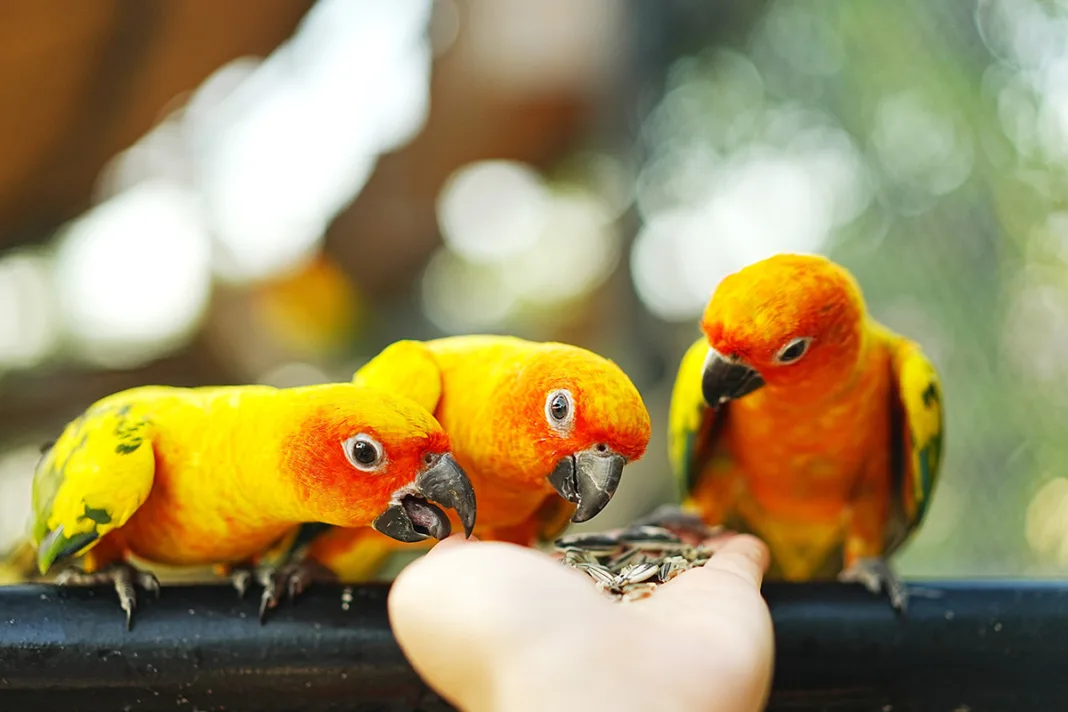DOT SCHWARZ discusses the pros and cons of pelleted diets and seed mixtures in this on parrot diets.
When Artha grey joined our home in the closing years of the last century, feeding seemed a pushover. All that was offered was parrot mix from the local petshop, a slice of fruit and fresh water changed daily. Then my vet said: “No more than 10 sunflower seeds a day.” I started removing sunflowers from the luxury brand and feeding most of them to the garden birds.
The seed mix that I bought contained plenty of monkey nuts in shells, until I found out that peanuts can be a source of aspergillosis. This respiratory disease can be a killer, so I started to pick out the peanuts, too. I began to read as much as I could. Twenty years later, pelleted (extruded, formulated) diets are gaining in popularity. Must I switch?
I grew up in a time when horses ate oats, dogs ate meat, pigs ate slop and poultry ate grains. Some years later, with a growing number of varied species of parrots and parakeets, I was advised to offer my birds pellets. Many different brands were already on the market. It’s not an exaggeration to claim that most veterinarians advocate their use as parrot food. The reason for this is that vets saw birds that were lethargic, obese and unwell when fed exclusively on seed diets.
Avian experts have usually developed these pellet diets. And they seem to be a good choice for those of us who are busy out at work. Read the list of ingredients carefully; you get what you pay for. Cheaper brands contain too many fillers, colourings and chemicals. I have tried different brands of pellets but never managed to get my birds to accept them willingly. Even one formulated, organic food with its superb reputation as the best of the best is tossed out of the bowl by my greys.
Baby birds that are weaned onto pellets appear to accept them more easily. I am now trying with some success to add a hand-feeding formula because it is high in protein (15 per cent) and low in fat (6 per cent).
Two of our good local petshops have closed. So, I buy my avian products from an online shop for parrots. Their compendious catalogue offers an equal number of pellet diets and seed mixes. Both types now offer specific diets for different species of parrot.
Pellets enjoy particular advantages. The content is baked with various proportions of grains, seeds, vegetables, fruits, proteins, vitamins and minerals. Essential nutrients are included in precise levels. Formulas can be generalist or created for specific birds (greys, macaws, canaries, parakeets, cockatiels, parrots and so on). This allows you to feed your bird the exact levels of protein, fat, fibre and other essential nutrients he needs to thrive.
Pellets also come in various colours and shapes, including uniformly brown or rainbow-coloured. (Check that the dyes used are natural. Each pellet or nugget is completely edible so there should not be mess from husks and hulls on the cage or aviary floor, unless the bird throws them out of the bowl – mine do.) Commercial pellet diets contain adequate amounts of vitamins and minerals for good health, frequently making supplements unnecessary. However, your bird may occasionally require nutritional supplements. Before supplementing your bird’s pellet diet, ask an avian vet’s opinion.
The best brands are costly. Unless the bird was weaned on pellets, birds have to be habituated to eating them. Most pellets look unappealing – do birds mind? Pellets do not suit all species uniformly; lories and lorikeets are one example.
A bowl of plump seeds looks appetising. You either believe, or you don’t, that the visual appearance affects parrots. Most enjoy eating seeds, too. Malnutrition is the leading cause of companion bird mortality, however. And most of the birds that suffer from this malnutrition were fed on a diet that only included seed.
Seed diets frequently cause nutritional imbalances, since a bird may eat only his favourites. Many seeds are also high in fat and low in many essential nutrients. Seeds lack Vitamin A, D3 and also calcium.
Dot Schwarz shares her life in rural Essex with an extensive mixed collection of parrots and parakeets.
Find more news and articles like this on the Cage & Aviary Birds website. Subscribe to Cage & Aviary Birds magazine now.


